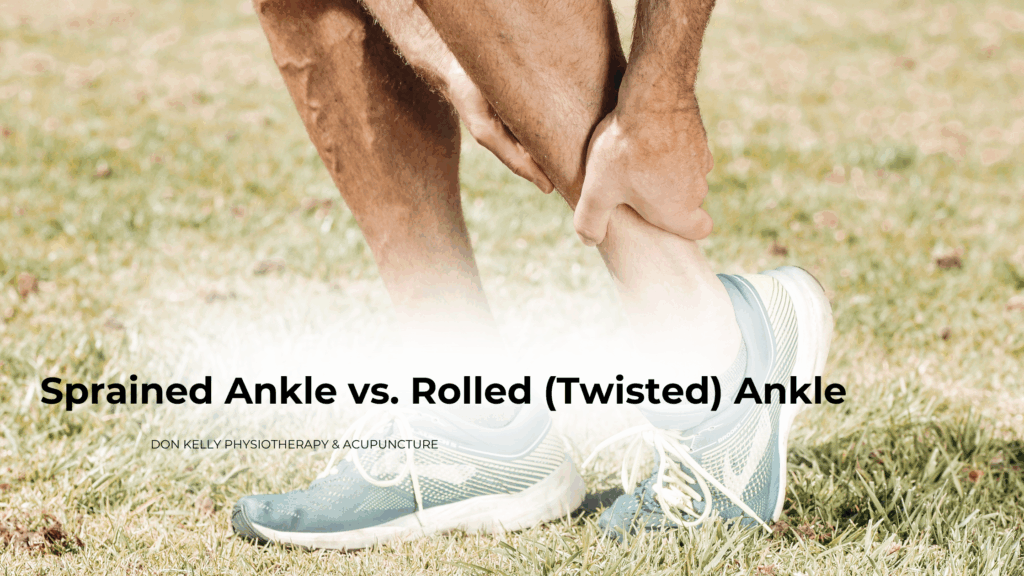At Don Kelly Physiotherapy and Acupuncture, serving Limerick and Charleville, we frequently see patients presenting with ankle injuries. Two terms often used interchangeably are “sprained ankle” and “rolled ankle.” While they are related, understanding the distinction is crucial for getting the right care and treatment.
What is a Rolled Ankle?
A “rolled ankle” or “twisted ankle” is a term used to describe the motion where your foot turns inward or outward sharply and unexpectedly. This sudden, awkward movement is often the cause of an injury.
Severity: A rolled ankle may cause temporary discomfort or mild pain that subsides quickly. In these less severe cases, it involves minimal stretching of the ligaments and may not result in significant damage.
Symptoms: Slight, momentary pain, and possibly minor tenderness. Often, there is little to no immediate swelling, and you can bear weight soon after the incident.
What is a Sprained Ankle?
A sprained ankle is the injury that results when the rolling or twisting motion forces the ligaments—the strong, fibrous tissues connecting your bones—beyond their normal range of motion.
Cause: A sprain occurs when these ligaments are stretched or torn. The severity can range from a Grade I (mild stretch) to a Grade III (complete tear or rupture).
Symptoms: Symptoms are typically more pronounced and persistent than a simple roll:
Pain: Often significant and persistent, especially when bearing weight.
Swelling: Immediate and noticeable swelling, sometimes with bruising.
Instability: The ankle may feel weak, unstable, or you may have difficulty walking.
Key Difference: A sprained ankle involves actual ligament damage, whereas a rolled ankle describes the mechanism of injury, which may or may not result in a sprain.
Rolled Ankle (Minor)
Minimal to none (slight stretch).
Momentary, mild, subsides quickly.
Little to none.
Sprained Ankle (Ligament Damage)
Varies from Grade I (mild stretch) to Grade III (complete tear).
Significant, persistent, worsens with weight-bearing.
Immediate, noticeable swelling and often bruising.
Grades of Ankle Sprain
The severity of a sprain depends on how much damage is done to the ligaments:
Grade 1 (Mild): Slight stretching or tiny tears in the ligament. Minor swelling or discomfort but you can usually still walk.
Grade 2 (Moderate): Partial tear in the ligament. Noticeable swelling, bruising, and pain with walking.
Grade 3 (Severe): Complete ligament tear causing significant swelling, instability, and difficulty putting weight on the foot.
Advanced Treatment for Ankle Recovery
At Don Kelly Physiotherapy, we don’t just treat the symptoms; we address the underlying mechanics to ensure you get back to full function, reducing the risk of a recurrent sprain. Our comprehensive approach goes beyond traditional R.I.C.E. and targeted exercises.
1. Dry Needling
Following a sprain, the muscles surrounding the ankle (like the peroneals on the outside of the lower leg) can become very tight and develop painful trigger points as they try to compensate for the damaged ligaments.
How it Helps: Our trained physiotherapists use dry needling to target these knots and taut muscle bands. By inserting a very fine needle, we can achieve an immediate release of muscle tension, improve blood flow, and relieve pain that is often difficult to reach with manual therapy alone. This allows us to progress faster with mobility and strengthening exercises.
2. Custom Orthotics
A significant risk after an ankle sprain is Chronic Ankle Instability (CAI), where the ankle repeatedly feels weak or “gives way.” This is often compounded by issues with your foot mechanics (biomechanics), such as an over-pronated (flat) or supinated (high-arched) foot.
How it Helps: We provide medical grade custom orthotics after a detailed assessment and gait analysis. These orthotics are custom-moulded to the exact shape of your foot.
They correct underlying biomechanical imbalances, providing a stable foundation.
They help align your foot properly, reducing the excessive motion that causes the ankle to roll or twist.
This tailored support significantly reduces strain on the healing ligaments and, most importantly, provides enhanced sensory input to the brain to improve balance and prevent future injury.
Getting You Back on Your Feet
Whether you’re recovering from an acute sprain or dealing with chronic instability from past injuries, our expert treatment plan combines:
Manual Physiotherapy
Targeted Exercise & Rehabilitation
Dry Needling to resolve stubborn muscle tightness and pain
Custom Orthotics to provide long-term stability and correct foot mechanics
If you’ve rolled your ankle and the pain, swelling, or difficulty bearing weight lasts for more than a day or two, or if you suspect a more severe sprain, don’t delay.
Early, professional intervention in our Limerick or Charleville clinic is the best way to prevent long-term complications.


